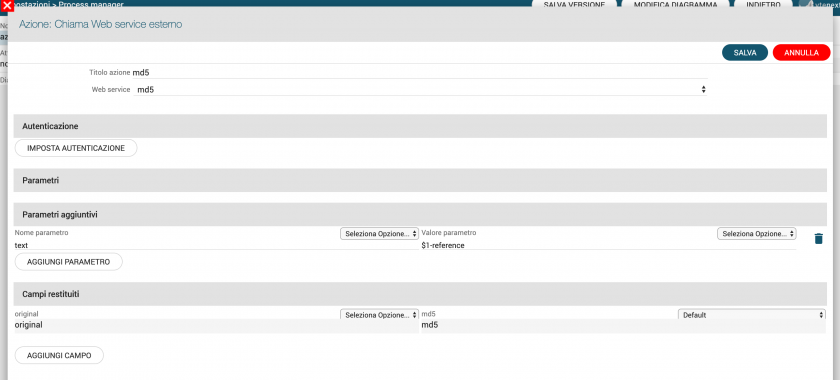BPMN Actions
Below the main BPMN actions:
1 - Create entity
2 - Update entity
3 - Delete entity
4 - Send notification
5 - Send email
6 - Send newsletter
7 - Create PDF
8 - Reset dynamic form
9 - Cycle
10 - Reset conditional fields
11 - Link entities
12 - Link static entities
13 - Transfer relations
14 - Insert table row
15 - Call external Web service
1 - Create entity:
This action allows to create record of system entities (standard or custom).
You can set a static or dynamic value for each one field (you can select values from involved process entities).
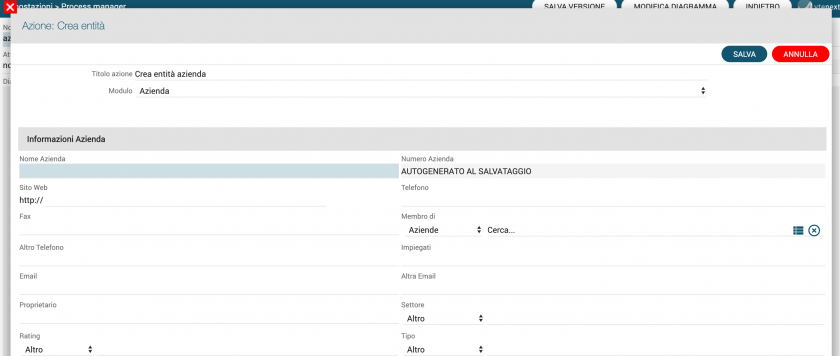
2 - Update entity:
This action allows to update an involved process entity or related ones.
You can set static or dynamic value for each one field (you can select values from involved process entities).
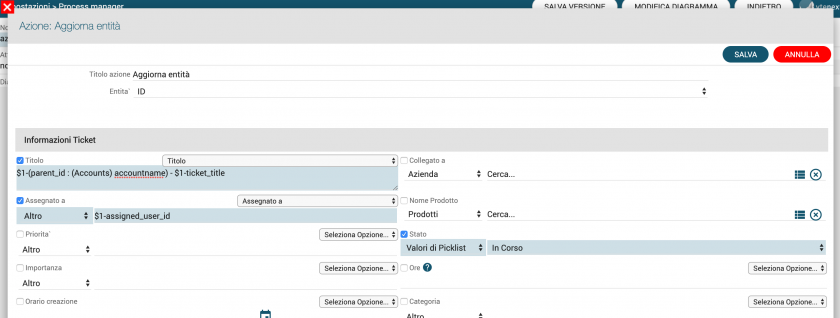
3 - Delete entity:
This action allow to delete a dynamic entity, an involved process entity.
This action is used in conversion processes cases, ex. conversion from lead to contact/account (deleting lead after the conversion) or in error cases, ex. re-planning of activities with creation of new entities and deleting the old ones.

4 - Send notification:
This action allow to send internal notification to the system users.
It's possible to set a specific text with static/dynamic data and relate entity. Besides, you can set the email parameters for the users that use email notification and not internal ones (you can change this settings into the user preference).
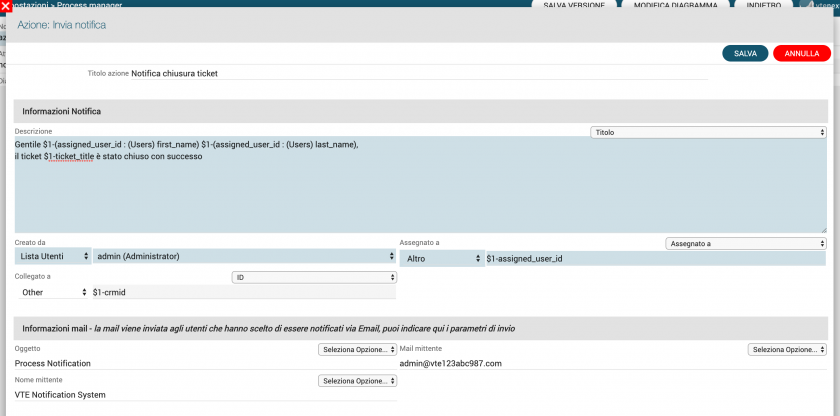
5 - Send email:
This action allows to send email with static/dynamic data.
It's possibile to set a static/dynamic sender email address (you can select email fields from involved process entities).
The same configuration is available for the email recipients (ex. record assigned user email , involved process partecipants, ecc).
Besides, you can relate the email to an involved process entity (or related ones). In this case, it will be possible to see a new message into the related list.
In the body message you can insert static/dynamic values and other general functions like current date/time, desired entity link (internal one for users or external one for portal customers).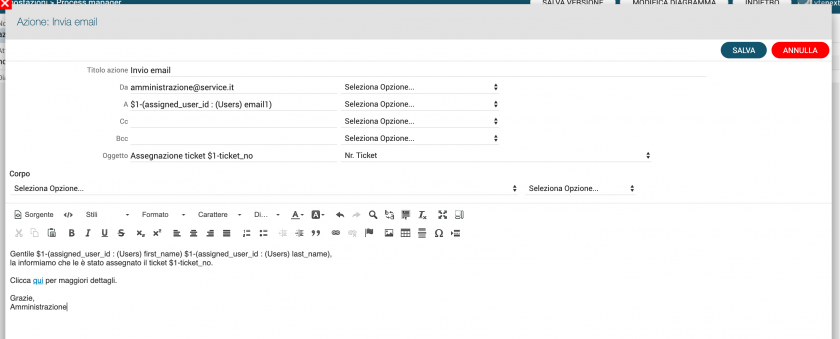
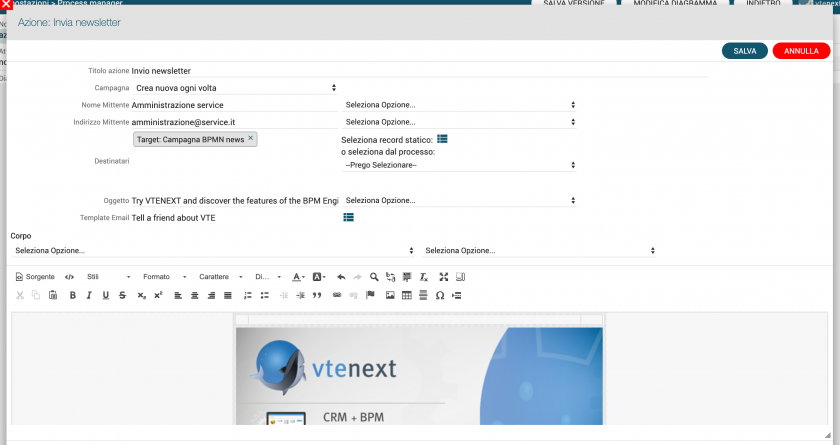
7 - Create PDF:
This action allow to create a PDF document using an existing template.
It's possibile to select the PDF entity, desired template, the entity to relate document, language, assigned user and document folder.
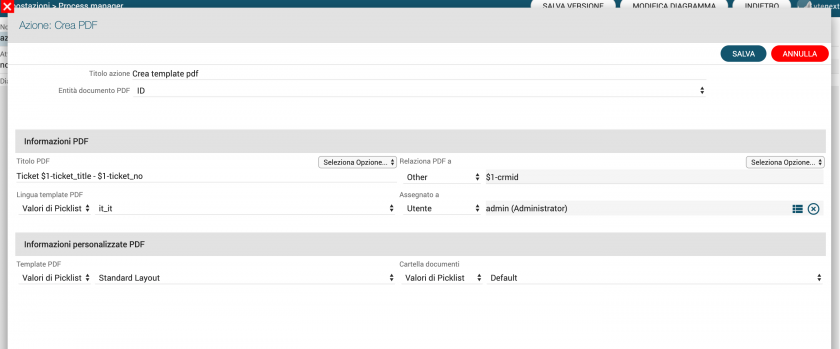
8 - Reset dynamic form:
This action is based on ProcessHelper usinguse and allows to clean its data off to re-use this one. So, it's used when the same Dynamic Form can be shown to the user many times. You need to clean its data to allow a new compilation.

9 - Cycle:
This action is based on Table field using.use. This one is not available if involved process entities (and related ones) haven't got this field into the module layout editor.
For each one table field row (and specific column conditions) is possible to send emails, create new entities, insert new rows (into the same field or other ones), delete rows, send notifications.

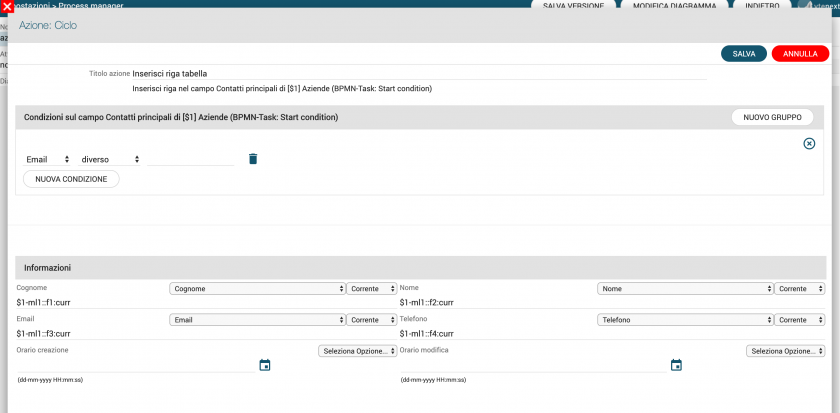
10 - Reset conditional fields:QuestaThis azioneaction èis riferitabased all'utilizzoon diprocess campiconditional condizionalifields lato processo.use. Infatti,Infact, èit's possibilepossible settareto campiset condizionaliconditional sull'entitàfields selezionataon the selected entity (coinvoltainvolved nelinto processo)the oppureprocess) basatior sulleinto Formthe DinamicheDynamic presentiform.
In nelthe processo.entity conditional fields case, these ones prevail over the general settings ones.NelThe casolast diones campiare condizionalidisabled sull'entità,till questithe prevalgonoprocess suiend campior condizionalian settati lato amministratore. Quest'ultimi vengono disabilitati sino al termine del processo o ad unaaction task di azionewith "ResettaReset campiconditional condizionali".fields" action.

11 - Link entities:QuestaThis azioneaction permetteallows dito relazionare tra lorolink 2 entitàentities dinamicheeach cheother presentanothose unahave relazionea N - N.N relation.LeThe 2 entitàentities infattihaven't nongot presentanothe unrelation campofield relazionatobut traa loro,N bensì la relazione ad N.relation.

12 - Link static entities:QuestaThis azioneaction permetteallows dito relazionare ad una entità dinamica del processo una o più entità statiche tra quelle proposte.Si rende utile per esempio per relazionare entità comunilink a piùspecific casistichestatic delentity flussoto stesso,an es.involved relazionareprocess loone.
It's stessouseful documentowhen you have to link the same entity to many ones into the process, ex. link the same document (informativaprivacy privacy,policy, checklist,checklists, ecc.)

13 - Transfer relations:QuestaThis azioneaction permetteallows dito trasferire/copiaretransfer/copy lethe entitàrelated relazionateentities dafrom un'entitàa adprocess un'altraentity delto processo.an other one.NelIn caso di relazionethe 1 - N irelation case, the record sarannowill trasferiti,be mentretransferred, nelwhile caso di relazionewith N - N irelation the record sarannowill copiati.be copied.TaleThis azioneaction siis rende utileuseful in flussiprocess diconversion conversionecases entitàwhere dovethe l'entitàstart dientity partenzais vieneconverted convertitato inan altroother eone, quindiso tutteall leits entitàrelated collegateentities allacan vecchiabe possonotransferred/copied essereto trasferite/copiatethe nellanew nuova.one. Es.Ex. In una processoconversion diprocess conversione dafrom lead ato contatto/aziendacontact/account tutte le entità che erano collegate al vecchioall lead possonorelated essereentities trasferite/copiatecan albe nuovotransferred/copied contatto/azienda.to Infinethe ènew possibilecontact/account. eliminareAt ilthe end it's possible to delete the lead senzawithout perdereany quindi tutte le azioni che erano collegate a questo.lost.
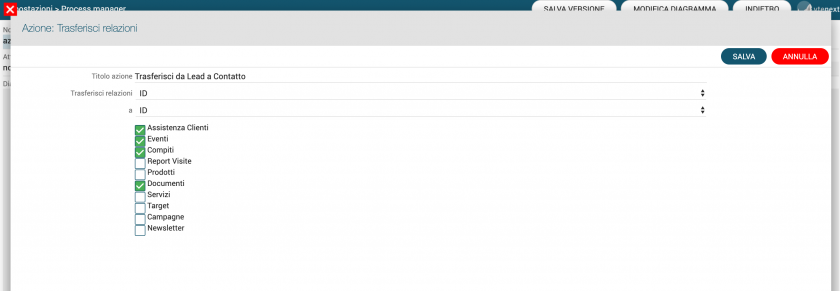
14 - Insert table row:
Questa azione è riferita all'utilizzo dei campi tabella. Tale azione non compare tra le disponibili se le entità (e relazionate) del processo non presentano tale campo nel layout editor del modulo stesso.
Tale azione permette di inserire una nuova riga nel campo tabella selezionato.
I valori inseriti possono essere statici e/o dinamici (presi quindi dalle entità coinvolte nel processo).

15 - Call external Web service:
Questa azione permette di richiamare un web service esterno di tipo REST.
E' possibile settare tutti i dati della chiamata lato Impostazioni -> Business Process Manager -> Web service esterni.
E' necessario definire l'endpoint da richiamare, autenticazione, eventuali parametri statici e campi restituiti.
Una volta settato il tutto è possibile richiamare uno di questi lato processo.
Da qui si possono definire parametri dinamici (nome e valore) e quindi la chiamata web service sarà effettuata con tutti i dati statici definiti lato impostazioni e i dati dinamici aggiuntivi definiti lato processo.
Nel flusso è possibile verificare se la chiamata è andata a buon fine in quanto questa azione restituisce sempre 3 parametri statici (success, response code e message code). Oltre a questi saranno presenti i campi definiti come campi restituiti e che si possono quindi estrarre dalla response. Nel caso di risposte complesse (oggetto con più attributi) è possibile estrarre questi sino ad un livello di escalation (indicando nome campo restituito e attributo, es. object.attribute).
Non è supportata la lettura di attributi nel caso di liste di oggetti come response.
